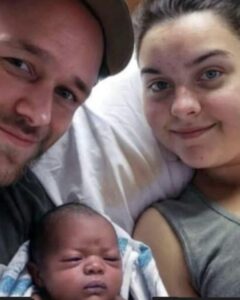“Our Baby Wasn’t the Color We Expected—But Her Eyes Told a Different Story”

My wife and I had waited months for this moment—the arrival of our first child. Surrounded by loved ones and overwhelmed with anticipation, we never imagined how quickly joy could twist into disbelief.
The moment our baby girl was born, silence fell like a heavy curtain. My wife stared at her, pale and trembling. “That’s not our baby,” she gasped. “It can’t be.” The nurse gently reminded her the infant was still attached by the umbilical cord. But my wife pulled away in horror. “I’ve never been with a Black man,” she cried, panic rising in her voice. Our relatives slipped out of the room quietly, their smiles gone.
I stood there frozen, ready to walk away, unsure of what to believe—until my wife spoke again in a trembling voice. “But… she has your eyes.”
And then I looked. Really looked. Her skin was a rich, warm brown. Her tiny hands curled into fists. Her cries rang out clear and strong. And her eyes—those unmistakable green eyes—were mine. In that instant, my heart cracked open.
Tears ran down my wife’s cheeks as the nurse placed our daughter into a bassinet and left the room. The air was heavy with questions. I sat beside her, barely able to speak. “What’s happening?” I asked.
She shook her head in disbelief. “I don’t know. I swear I don’t.”
Tests were done. Every possible scenario was explored. No switch had been made—the baby was genetically ours. Yet the question remained: how?
We scoured our family trees, hoping to uncover some lost heritage that could explain it. Nothing surfaced. All we had was a mystery—and the growing realization that our child was, undeniably, ours.
At home, we tried to adjust. But the world outside made it harder. People stared. Friends grew distant. My wife, once so outgoing, barely left the house. I held us together the best I could, but uncertainty weighed heavily on both of us.
Then one night, I found her sitting alone with an old album on her lap. Her voice was soft but steady. “I need to tell you something.”
Years ago, in college, she had donated eggs to a fertility clinic. It was a decision born out of financial desperation—one she had nearly forgotten. But now, it was the only explanation that made sense. “What if… what if my egg was used?” she whispered. “And someone else’s sperm—someone Black?”
The theory was wild. But then I found the letter—hidden among old documents. A formal apology from the clinic, confirming an internal mistake. Her donated eggs had been used in another patient’s procedure. They had only just discovered it. They were deeply sorry.
We sat in stunned silence. There was grief. There was anger. But there was also something else—clarity. We named our daughter Mia. And we chose to see her not as the result of a mishap, but as a miracle.
She grew into a bright, fearless child. Her laughter filled our home again. She asked endless questions, loved music and bugs and books. And we embraced every piece of her story.
One afternoon, when Mia was five, she came home with a question: “Daddy, why don’t I look like you and Mommy?”
I knelt down, took her hand, and said, “Because you’re special. You came into the world with a little extra help—and a whole lot of love. That makes you unique. And beautiful.”
She beamed. “I like that,” she said. And so did I.
In the end, Mia didn’t just change our lives—she transformed how we saw the world. What began in confusion became a journey into something deeper than DNA. A lesson in love. A reminder that families aren’t built on appearances—they’re built on trust, acceptance, and the choice to love no matter what.